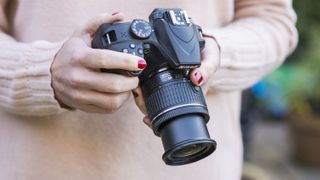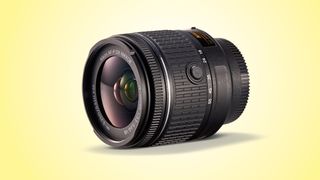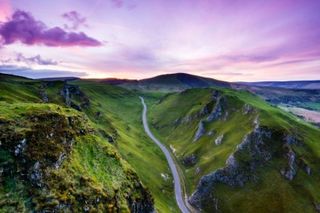Got a new camera? Here's how to take great shots with your bundled lens

If you've just got a new camera, whether it's a DSLR or mirrorless camera, the chances are that you've bought it with a bundled lens.
These lenses are often referred to as 'kit' lenses, as they're normally sold as a kit with a DSLR or mirrorless camera, allowing you to start taking pictures straight away.
A kit lens normally covers a broad focal range, what we'd term as 'standard' zoom range, from moderate wide-angle to short telephoto. This is typically 18-55mm on most entry-level DSLRs, while it's a bit more varied on mirrorless cameras, with 16-50mm, 15-45mm or 14-42mm (on Micro Four Thirds) popular kit lens focal ranges. These lenses allow you to shoot a range of subjects if you're just starting out on your photographic journey and haven't thought about investing in other lenses just yet.

Though there are some exceptions, these lenses are pretty primitive to make them as affordable as possible. They feature a relatively slow variable maximum aperture (normally f/3.5-5.6), which means they can make some photography a little restrictive at times, especially when it comes to lowlight shooting and isolating your subject from the background.
Don't let that put you off though. Armed with our expert tips and tricks, you'll be able to achieve stunning shots with your humble kit lens
Shoot landscapes like a pro
Landscape photography is one of the most popular genres, and your kit lens is perfect for taking fantastic scenic shots. All you need to do to get started is to set the focal length to its widest setting. This will give you a wide field of view; perfect for taking in an entire scene.
The next thing you'll need to do is set the camera to aperture-priority mode, which is done by turning the mode dial on your camera to to A (or Av on Canon cameras). This allows you to control the aperture and depth-of-field, while the camera automatically sets an appropriate shutter speed. Then set the aperture to the 'sweet spot' setting of f/11.

The sweet spot of the lens is the aperture at which a lens produces the best possible image quality and sharpness, and kit lenses perform very well at this setting or thereabouts. You can see for yourself by taking another shot at f/22 - the image will more than likely be a little soft.
As for your camera's ISO, you want to keep this as low as possible - ideally around ISO100. If you're going to be shooting at f/11 at ISO100, it's likely that you'll see the shutter speed drop, so to avoid camera shake we'd recommend using a tripod to keep your camera stable.
Now to set the focus. With your camera on a tripod, switch the camera to its Live View shooting mode, so rather than using the viewfinder you're using the rear screen.
Zoom into the image on the LCD screen so you are looking at a position that's one third of the distance into the scene and either move your focus area over it, or tap focus (available on some cameras). Zoom back out of the image on screen and start shooting - you should find that you'll get your sharpest shots ever!
Take better portraits
When you're taking portraits with your kit lens there's a quick and easy way to instantly improve your shots. Turn the zoom ring until the lens is at the longest focal length, which on many kit lenses will be 55mm.
This focal length provides a comfortable distance between you and the model/subject, and reduces the risk of distorting their features by using a wide-angle focal length and getting too close.

Try to avoid using your kit lens at 18mm for most portraits as it can distort features
Switch your camera to aperture-priority mode, which is usually represented by A or Av on the mode dial. Next,` set the aperture to f/5.6 because this is the maximum aperture setting you can use when the camera is zoomed in to 55mm. This aperture combined with the focal length will give you the best chance of blurring the background so it's not distracting.
Now all you need to do is position your model a few metres in front of a plain background such as bushes, a fence or a wall etc. Then by moving position rather than zooming to frame your shot, you can compose your image and start shooting.

Setting your lens to 55mm at f/5.6, with a good separation between your subject and background will reward you with much better portrait shots
Get closer to the natural world

To shoot great close-up shots of flowers and insects, don't you need a dedicated macro lens or other specialist accessories? The honest answer here is not necessarily. While a kit lens alone won't get you all that close to the minutiae of the natural world, a simple and inexpensive accessory will transform it into a macro lens.
Reversing rings have a lens bayonet mount on one side, and a filter thread on the other. This allows you to screw the ring onto the front of your lens, and then to attach it to the camera backwards using the lens mount on the other side. One of the problems with using a reversing ring with a kit lens is that without taking advantage of a simple trick while the lens is mounted backwards, the aperture will remain wide open and depth-of-field will be incredibly shallow (there won't be much of the subject in sharp focus).
How to use a reversing ring with Canon kit lenses
Mount the kit lens on your camera the normal way, with the reversing ring attached to the front, and in aperture-priority mode set the aperture to f/8. Now hold down the depth-of-field preview button and keep it held down while pressing the lens release button and twist the lens to remove it. The aperture will now be set at f/8, and you can re-attach the lens to the camera by the reversing ring. This trick may also work for other camera brands, but not Nikon kit lenses.
How to use a reversing ring with Nikon kit lenses
With a Nikon kit lens simply attach the reversing ring to the front of the lens, and attach the lens backwards using the bayonet mount on the reversing ring. With the rear lens element facing outwards you'll see a mechanical lever – this controls the aperture. Now by moving the lever and holding it in position, around the centre of its travel, you will have aperture set to roughly f/8. The downside is that you have to hold it in position while shooting.
Setting the focal length of the lens to 18mm allows you to focus closer to the subject for a close to macro shot. While 55mm will allow you to focus further away for a close-up, but not macro shot. To focus simply move the camera backwards and forwards slightly until the image looks sharp in the viewfinder.

Take more control
To say that a kit lens is a jack of all trades master of none is a tad unfair. They are versatile and not aimed at one or two specific types of photography. But by simply taking a little more control and thinking about the camera and lens settings you're using, they can be great for many subjects. Next time you're out shooting give the techniques we've looked at here a try, and you're sure to see an instant improvement in your landscapes, portraits and close-up photography.

Comments
Post a Comment